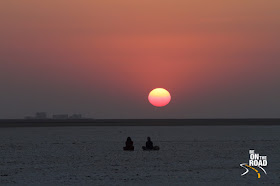
This region was once the base for one of mankind’s earliest and most successful civilizations. I am talking about the Indus valley civilization as the mighty Indus river meandered its way into the Gulf of Kutch making this an extremely fertile valley. Maritime trade with the Middle East and Africa made it one of the most successful on the Indian subcontinent. Engineering and business thrived making it an extremely rich place. But, somewhere after the devastating earthquake of 1819, the land completely transformed.
The Indus shifted its course to today’s Pakistan and the land dried to form one of the largest salt deserts of the world. But, the beauty of mother nature’s transformation is that it creates something sensational and in this case it is the spectacle of the thick white salt crystals that sprawl an area larger and bigger than what the eye can see. The expanse is so mighty that if you walk in the middle of it for a while, you might lose your sense of bearings as your 360 degree view remains more or less the same, which is white all the way.
And that I think it is this sheer vastness, bleakness and remoteness that makes this place so surreal. It offers something that is a total rare commodity. Be it the sunrises or sunsets here, the moonrises, the look of the star glazed sky on a no moon night or the reflections of the moon on the white salt crystals on a full moon night, every regular celestial event seems to become a spectacular sight here.
Located real close to the Dhordo tent city that celebrates the annual Rann Utsav festival, this part of the Greater Rann of Kutch that locals fondly refer to as the White Rann is maintained by the Indian army as our border with Pakistan passes somewhere in the middle of this remote expanse. The character of the Indian army adds a special charm to the entire White Rann experience as you can see them almost everywhere right from the check points, the surrounding areas and even the main entrance to the White Rann. Your respect for the border force increases many fold when you see the unforgiving nature that they live in, especially in the summer months, when temperatures consistently hover 50 degree Celsius or more.
A trip to the White Rann doesn’t simply entail a sight of one of India’s best natural wonders, but it also allows you to experience the colors, handicrafts and art of the creatively rich Kutchi people, the amazing Gujarati cuisine and a closer peek at Greater Flamingos, Lesser Flamingos, Bustards and Wild Asses that call this salt desert their home. I sometimes ask as to why do we find the most color in dry landscapes. May be, we humans tend to over compensate to make up for the lack of color. Most of us think Rajasthan is India’s most colorful state, but I think the region of Kutch will beat it hands down. And not just that, the art, culture and handicrafts that has been passed down many generations for hundreds of years bears testament to the rich history of this place. In all, a total holiday package to one of Incredible India’s most beautiful and vibrant locations. And if you happen to be there tomorrow, do not miss the special celestial event of Blue Moon, Super Moon and Lunar Eclipse from this salty desert.
Best Season to Visit
October to March should be the the best time to visit this region, though I would say November to February is best, if you yearn for pleasant weather.
Where to Stay
Gujarat Tourism runs two tent city properties real close to the White Rann. These places are a bit on the pricier side, but they offer a perfect place for your Kutch family holiday as they bring entertainment, food, culture, shopping and luxury all in one massive cultural city. If you are on a road trip and are looking for budget options, stay with Kutchi families in their village homes for a more authentic experience. What you lose in oomph, you make up for in true local character. Villages such as Nirona, Gandhinugram, Bhirandiyara are great bets as they offer you a rustic Kutchi experience while offering proximity to the White Rann.
How to Reach
Bhuj is the city with the closest airport and railway station, but connectivity is limited and cost might be a bit high, especially for flights. For cheaper options, look at Ahmedabad, though this would mean you drive close to 400 kilometers to reach the White Rann.
No comments:
Post a Comment